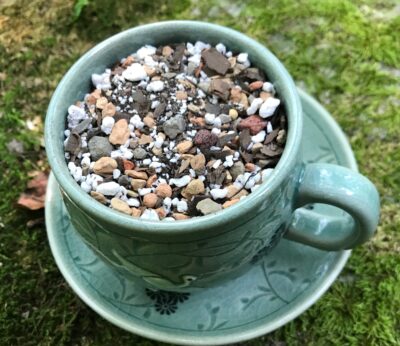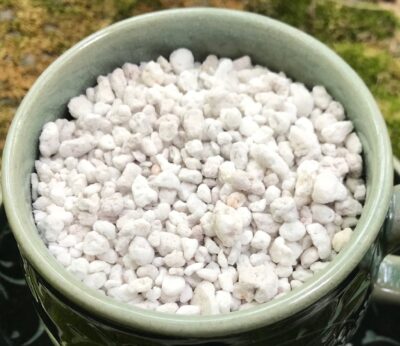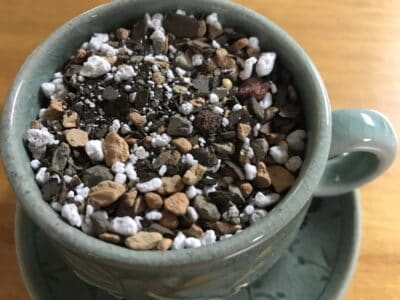This post contains affiliate links.
Have you ever opened up a new bag of potting soil and noticed that it has lots of little white balls or dots of something mixed into the soil and wondered what those things were?
Potting soil is often enhanced with perlite which is a lightweight volcanic mineral. This is done to improve soil aeration and is crucial for the growth of many plants, especially succulents and cacti.
Although I knew what they were, curiosity about the composition of potting soil piqued my interest, prompting me to want to learn more about perlite and its purpose in potting soil. Not only did I want to know more about its purpose, I also wanted to know where it comes from and if it is a naturally occurring material or a man-made one.

White Balls in Your Soil, What Are They?
If you’ve ever noticed those small white balls in your potting soil, you’re not alone. Some people refer to them as white dots or white balls, but they are actually a volcanic material known as perlite.
Perlite looks and feels somewhat like small styrofoam balls and is often added to potting soil to improve the soil’s aeration and drainage.
It does this by loosening up the soil structure. In other words, it helps prevent the soil from becoming compacted over time. This is very important for plants like succulents and cacti since they need soil that is loose (has good aeration) and drains quickly. Compacted soil would prevent the soil from draining, keeping the soil wet– which is not good for those plants.
Perlite is porous and does hold some moisture, but not as much as vermiculite, another mineral sometimes added to potting soils. So it is better suited for succulent and cacti soils than vermiculite.
Perlite also holds air and that is why it’s used in potting soil to improve its aeration. Good aeration allows your succulents and cacti roots to thrive.
If you crush one of those pieces of perlite between your fingers, it will crumble and become powdery, but if left alone in the soil, it will not decompose or disintegrate easily.

Where Can You Find and Buy Perlite?
Perlite is often added to potting mixes and those potting soil mixes can be found and purchased at your local garden center. These stores will also sell you bags of Perlite too.
If you want a convenient way to buy perlite for your garden needs, you can also check out what Amazon has to offer such as this bag of Miracle-Gro Perlite.
It is useful to have some of this in with your garden supplies for when you want to make your own potting soil and when you do, you might want to check out our article on what makes up a good cactus soil mix, and our other guides on how to make cactus soil and succulent soil.
What is Perlite Made Out of and is it Natural or Man-made?
Perlite is made out of a type of naturally occurring volcanic glass of the same name. This volcanic glass is made up of mostly silicon dioxide as well as several other “oxides” and a small percentage of water. It is changed from its natural form by heating it in an industrial oven.
It usually starts off as a black or dark gray colored glass. To make the white-colored perlite that you see in potting soil, this volcanic glass (obsidian) is heated to around 850-900 °C, ( 1,560-1,650 °F ). The glass expands due to the water turning to steam and forms into the white, lightweight, perlite balls that you see in your potting soil. This process is very similar to the way popcorn kernels pop when their water content turns to steam.

What Other Uses Are There For Perlite in Gardening?
We already mentioned how useful it is as a soil amendment – to help with aeration and to prevent compaction, but there are other uses gardeners have found for perlite in their gardens. These uses are for general gardening and not necessarily for succulents or cacti.
- ~ As a Covering Medium
Some people like to add a thin layer over the top of the soil as a way to maintain soil temperatures when they are trying to germinate seeds or to protect the seedlings. It will also keep in some moisture to help in the germination of those seedlings and even protect against slugs or other insects.
Perlite can be used as a top dressing for succulents and cacti, but I prefer to use pumice because the perlite is so lightweight that it doesn’t stay in place. - ~ In Hydroponics
Perlite can be used as a medium to propagate plants from cuttings. Coarse perlite can even be used as a hydroponic growing medium for low-flow watering systems. It wouldn’t be suitable for high-water systems since it is such a lightweight material that it wouldn’t stay in place.
It is also often mixed with other mediums such as vermiculite.
Succulents can be grown hydroponically with a weaker solution and the correct know-how, but I don’t think they are particularly suited for hydroponic gardening.

Pros and Cons of Using Perlite With Succulents and Cacti
| Pros of Perlite | Cons of Perlite |
| Improves soil aeration and provides excellent drainage, preventing waterlogged soil. This helps prevent root rot by reducing excess moisture. | Tends to float to the surface when watering, making it less visually appealing. It can also be blown away or scattered easily. |
| Very stable and doesn’t easily disintegrate or decompose. | Perlite may not easily disintegrate or decompose, but will break down over several years, necessitating replacement, |
| Low-cost and easily available | Nonrenewable resource. |
| Reduces the risk of overwatering, promoting healthier growth. | This may cause soil to dry out quickly, requiring more frequent watering. |
| Easy to handle and mix with other soil components and is non-toxic. | If not rinsed before use, perlite may contain dust that could irritate the respiratory system. |
For further information, here’s an interesting video about Perlite:
This post was written for cactus-central.com and is not permitted to be used on other sites.
